How to become a successful farmer from a peasant.

Krivyanskaya village, view from the outskirts.
Intensive vegetable growing in Rostov Oblast
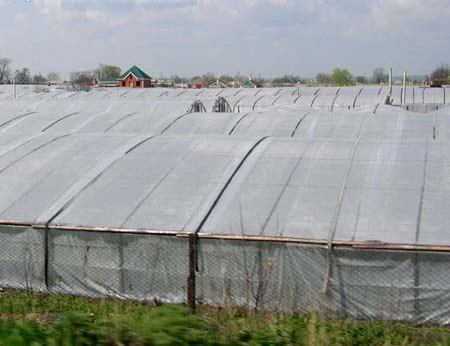 Krivyanskaya village is famous not only in Rostov and the region. The famous "Krivyansky tomatoes" are well known to Moscow residents and they buy them with pleasure.
Krivyanskaya village is famous not only in Rostov and the region. The famous "Krivyansky tomatoes" are well known to Moscow residents and they buy them with pleasure.
This village can be considered almost as a kind of example of peasant enterprise and truly effective use of land. The vast majority of residents grow tomatoes and achieve great success, primarily economic. Therefore, the village of Krivyanskaya, from my point of view, is an example of solving both agricultural and social issues, as well as employment issues, including for residents of neighboring settlements.
The material standard of living of many villagers is clearly higher than in other villages and settlements. The peasants achieved all this through hard work, and not by waiting for an uncle from the region, ministry or government to take care of them.
But success requires not only hard peasant labor from dawn to dusk, but also technology. And here, the Krivyanskaya residents have gone quite far compared to others. They were among the first to start growing vegetables in tunnel greenhouses, started using drip irrigation, intensively use fertilizers, etc.
In the photo on the left, a typical garden plot in the village of Krivyanskaya.
Judging by what I saw, as well as analyzing the data available to me, I came to the conclusion that most have already reached maximum productivity with existing technologies and it is time for the Krivyansk residents to think about the next step: moving to the next level of agricultural technology and agricultural technology.
The first stage, when the simplest tunnel and arched greenhouses were built on garden plots, can be considered successfully completed. Construction was carried out according to the principle of minimizing costs. The simplest and cheapest metal, and sometimes wooden frames, the cheapest film for shelter, later - the cheapest available drip irrigation. And it was really justified. It was necessary to get the maximum possible profit while minimizing cash investments in order to feed the family during the year and have funds for developing production next year.
Practice has shown that the cheapest materials do not always allow you to get a guaranteed harvest. Therefore, in recent years, many Cossacks began to use, for example, a film for covering greenhouses of higher quality, although more expensive. Additional costs immediately affected the receipt of a higher and guaranteed harvest. Now the film withstands the entire period of growing tomatoes. Many Cossacks are wondering: what to do next? How to make sure that the harvest is really planned and predictable?
I received a letter from one of the residents of the Cossacks - Vladimir Antipov, who writes:
Hello!
New technologies in the production of protected ground tomatoes (drip irrigation, fertigation) appeared in our country several years ago, but there is a lack of information. I would be grateful for your opinion on the following issues:
Water-soluble fertilizers: the most popular with us are complex fertilizers from Valagro (Master), Yara (Kristallon), Kemira, but recently new ones have appeared: Haifa (Polyfid), Nutrisi (Terraflex), MCF (Amkobest). What are your recommendations regarding the best of the listed ones? How justified is the advice to choose fertilizers containing at least 75% ammonium nitrogen in the composition of total nitrogen? Is it justified to replace complex water-soluble fertilizers with simple ones: sulfates, nitrates, monophosphates, etc.? After all, knowing the NPK ratio by growth phases, you can adjust the composition of the solution with the addition of microelements.
We have alkaline soil pH 8. Considering that in the fruiting phase we increase the proportion of Potassium, then in order to maintain the desired ratio (Ca: K = 0.6-0.8), we more often add Calcium nitrate, which further alkalizes the soil. And is it necessary to take into account the pH of fertilizers at all (let's say we prefer sulfates K, Mg as more acidic than nitrates K, Mg), and how realistic is it to change the acidity of the soil in the root zone given the buffering capacity of the soil?
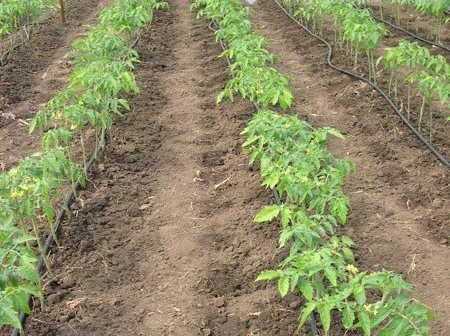 After reading the letter, I decided that many questions, or rather answers to them, would be of interest not only to Vladimir, but also to other people seriously involved in growing early vegetables. In this article, I will talk about technologies that allow us to achieve stable and reliable results.
After reading the letter, I decided that many questions, or rather answers to them, would be of interest not only to Vladimir, but also to other people seriously involved in growing early vegetables. In this article, I will talk about technologies that allow us to achieve stable and reliable results.
I was in Stanitsa Krivyanskaya in May of this year and have an idea of the volumes and technologies of tomato production. Firstly, I really liked the fact that people in the village it works, and does not complain about the difficulties of life! Nevertheless, the development of vegetable growing is going on by touch, without an integrated approach, individual components of technologies are pulled out and introduced purely intuitively. Intensive use of fertilizers when growing plants in the soil, with the impossibility of systematic laboratory control, correction and replacement, will certainly lead to its degradation and, as a consequence, a decrease in yield. The use of mineral fertilizers for the soil is definitely effective, but, ultimately, will lead to both structural and irreversible chemical changes in its composition, which in turn will affect the yield and quality of tomatoes. The use of large volumes of soluble fertilizers, often uncontrolled and excessive, also leads to negative environmental consequences. Fertilizers penetrate into groundwater and change its composition.
When growing plants in the ground, the only sufficiently effective way to adjust the composition of fertilizers is foliar diagnostics, which will allow you to quite correctly and timely adjust top dressing, but this method is not always available and is quite expensive. Such services are provided by agrochemical laboratories, but as far as I know, there is no such laboratory in the village.
Vladimir writes that fertigation is already used, but I did not see in any of the greenhouses that I was able to see devices that would allow for precise dosing of fertilizers, as well as devices for automating irrigation. Therefore, the "fertigation" method, when a bag of fertilizers is poured into an iron barrel, and then they are fed in an unclear proportion to the plants, can be called fertigation with a very big stretch. This is probably more like simple feeding.
What can be proposed in terms of a radical change in the technology of growing tomatoes in Krivyanskaya? I think that the problem needs to be solved in several directions:
Transition to an artificial substrate.
The soil in greenhouses, especially after many years of use, degrades and does not have the best agrotechnical properties. In addition, it accumulates pathogens and pests. The soil can be restored. It can be treated with steam, special fungicides, or simply replaced. However, replacing a 40-50 cm thick layer of soil is not an easy and very labor-intensive task. In most countries of the world with intensive vegetable growing, artificial substrates are used. They allow you to get away from many problems associated with growing in the ground.
Advantages:
- An artificial substrate will allow you to get rid of the influence of the physical and chemical state of the soil on ensuring balanced plant nutrition.
- You will need significantly less water and fertilizers per 1 kg of produce.
- Allows you to use a fully automated irrigation and fertigation system.
- You can get an earlier harvest due to the favorable temperature regime in the root area.
- Significantly reduced risk of diseases, such as late blight, and damage to the root system by nematodes.
- Complete absence of weeds.
- As an additional measure, a continuous covering of the greenhouse floor with a special material is used.
Disadvantages:
- Additional equipment costs greenhouses.
- The need for a complete replacement of the substrate approximately once every 3 years.
Irrigation.
Today, the main criterion for choosing drip irrigation tubes is their cost. Most Krivchans use the cheapest tubes, which are barely enough for normal operation during one season. As a rule, these are uncompensated tubes and often even quite expensive tubes of this type do not meet the requirements for uniformity of irrigation and other characteristics. I observed the operation of drip irrigation mounted on fairly expensive pipes of Syrian production, and with a greenhouse length of about 100 meters, the difference in water output from the first and last droppers in a row was almost twofold. That is, in order to give a normal amount of water at the end of the row, you need to arrange a swamp at the beginning. Thus, the selection of the type of drip irrigation tubes should be approached more carefully. Not everyone uses filters. And working without filtration is unacceptable, as it leads to clogging of the system and uneven watering.
Correct selection of tubes, even if it seems expensive to you, can be more cost-effective. A quality tube works reliably for 5-7 years without replacement. Cheap, so-called "tapes", often do not provide reliable watering even for one season. These are so-called "disposable" products. A simple calculation will give you the desired result. Instead of a quality tube that will last you 5 years, you will have to buy a disposable one every year, that is, 5 times. For greenhouses longer than 50-60 meters, it is advisable to use tubes with compensated drippers. They guarantee stable and uniform watering along the entire length of the rows.
Fertigation.
Fertigation is really effective on artificial substrate. In addition, it is imperative to use precise dosing, automatic control and irrigation management. This is not an easy task, which will require equipment costs, but such a system is completely justified.
This year, we have implemented several fertigation systems developed by our company in greenhouses in Bashkiria. They have shown good results and are cheaper than similar systems available on the market. These systems operate in the village of Tuymazy and in the greenhouse farm "Flowers of Bashkiria". The photo shows one of the fertigation units.
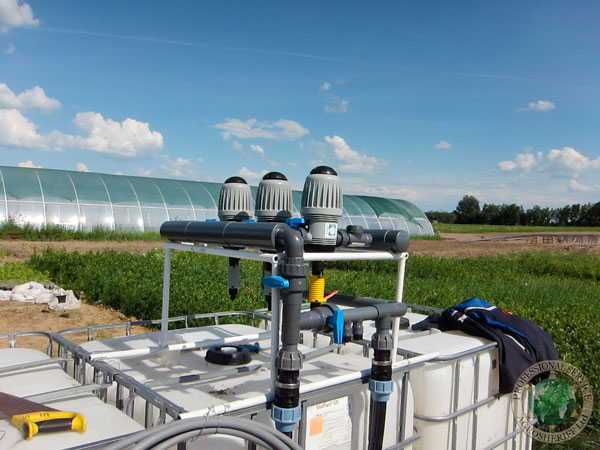
The main elements of the device are 3 MixRite pumps. Two of them add 2 types of dissolved fertilizers to the irrigation water, the third pump adds acid. The system is equipped with a device that monitors the acidity and electrical conductivity of the irrigation water, devices that monitor the condition of the filters and signal their clogging, as well as a controller that allows you to program irrigation for up to 8 independent irrigated zones.
The system is mounted on the wall of the greenhouse. Acid and concentrated fertilizer solutions are placed in plastic containers and fed through tubes to the dosing pumps. Containers with solutions are not shown in the photo. MixRite pumps allow you to easily adjust the concentration of fertilizers supplied to the irrigation system and their ratio to each other. The pH (acidity) of the irrigation water is also easily adjusted.
This fertigation and automation system is quite flexible and allows you to modify it to almost any customer requirements. You can change the number of dosing pumps, as well as other system parameters.
Using such a fertigation system, you can use any type of soluble fertilizers or make solutions from individual components according to your own recipe.
Read more about dosing pumps in this article.
The questions that Vladimir asks about soluble fertilizers from different manufacturers cannot have unambiguous answers. In terms of quality, imported fertilizers are approximately the same. In terms of the ratio of nutrients, they can be selected according to generally accepted recommendations. Read the recommendations in this article.
I would like to note once again that fertigation is really effective on artificial substrates. On the soil, without a well-equipped laboratory and a qualified agrochemist - soil scientist, giving recommendations in absentia is a futile exercise.
Temperature conditions.
Maintaining the optimal temperature is one of the important points that contribute to obtaining an early harvest. There are two problems: heating at the end of winter and cooling in the hot summer months.
Heating.
Most of the heating devices currently used are quite primitive and cannot provide the optimal temperature conditions. For small greenhouses, which are used in Krivyanskaya, it makes sense to consider the possibility of using air heating, when air heated by a special heater is evenly distributed throughout the greenhouse through perforated plastic sleeves. New water heating systems have also been developed with hot water supplied through small-diameter plastic pipes, which are located near or under containers with substrate. Such a system is especially effective when using an artificial substrate.
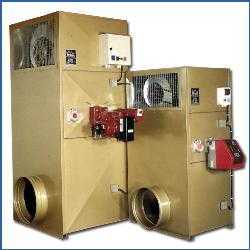
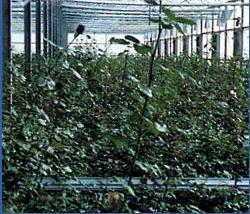
Lowering the temperature on hot days.
Two methods are used for this: ventilation and shading. The greatest effect can be achieved if the side walls of the greenhouse are opened for ventilation. For this purpose, a simple device with a manual or electric drive is used. Instead of film, it is advisable to use a special material made of polypropylene, which lasts up to 5 years, but you can also use a film with a thickness of 180-200 microns.
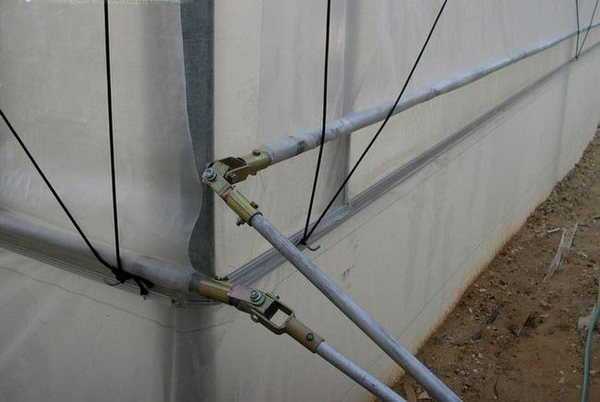
Manually operated side curtains.
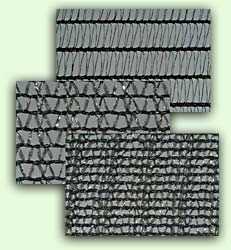
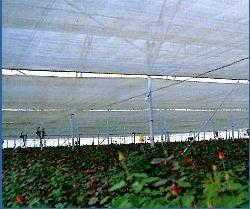

The best option for shading is a thermal screen. It not only shades the greenhouse on hot days, but also, if closed at night, retains heat well in the greenhouse. Unfortunately, most of the existing arched greenhouses and has too small a height for placing a thermal screen.
For shading simple arched greenhouses, you can use the same mesh as for a thermal screen, but simply throw it over the greenhouse on top of the roof. The optimal mesh density is 40% shading.
Shading meshes with a metallized fiber coating are called "aluminet" (pictured on the right). Such nets are more effective in protecting against heat, and also as thermal screens to retain heat in the greenhouse at night.
Nets are available with varying degrees of shading - from 20 to 80%
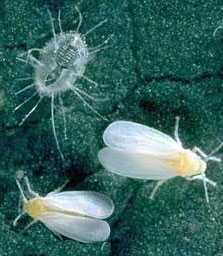
Plant protection.
How to reduce plant contamination from infections accumulating in the soil, or eliminate it completely, I have already written above - this is the use of an artificial substrate and covering the soil with special materials. The use of drip irrigation and fertigation in this case is a must.
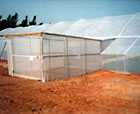 If you continue to grow plants in the ground, you can recommend using mulching film. Two-color mulching films are very effective, the lower side of which is painted black and the upper side is white. Such mulch not only retains moisture well and protects plants from soil infections, but also significantly increases the illumination in the greenhouse, increasing plant photosynthesis.
If you continue to grow plants in the ground, you can recommend using mulching film. Two-color mulching films are very effective, the lower side of which is painted black and the upper side is white. Such mulch not only retains moisture well and protects plants from soil infections, but also significantly increases the illumination in the greenhouse, increasing plant photosynthesis.
Great harm to the crop is caused by infection of plants with diseases, including viral diseases, the carriers of which are small insect pests, such as whiteflies, which freely penetrate the greenhouse during ventilation. There is a simple and effective way to protect plants. It consists in simply not allowing the pest to enter the greenhouse. For this purpose, a special phytoprotective net is used, which covers all the ventilation openings in the greenhouse.
It is also advisable to make the entrance vestibule to the greenhouse covered with the same net.
Several types of nets are produced that can completely protect the greenhouse from the penetration of small insect pests into the greenhouse. They have slight differences related to transparency and mechanical characteristics, but are approximately the same in terms of protection from insects.
The use of such nets allows you to make the side walls of the greenhouses completely openable. The net also protects the plants in the greenhouse from gusts of wind when ventilating.





The photo shows various types of phytoprotective grids.
Everything described above is quite easy to apply in the greenhouses of Krivyansk farmers.
I hope that this article will help those who are planning to move from amateur vegetable growing to professional. All these techniques, equipment and materials are considered standard in countries where vegetable growing is widely developed.
A little about the economy.
Why did Krivyansk Cossacks, not having tens and hundreds of hectares of land, but using only their own garden plots, become successful farmers?
A large farm size is not always the basis for obtaining large incomes. World practice shows that in greenhouse vegetable growing for a family farm, the optimal greenhouse size is from 0.2 to 0.5 hectares.
A larger greenhouse farm is already a serious enterprise with a large permanent staff of workers, its own sales service, high energy consumption, etc. A large enterprise may not always be as effective as a small family farm.
Using an integrated approach to growing vegetables, competent and correct application of technologies, materials and equipment is the path to stable production and economic success.
Tomatoes have a biological yield potential of about 50 kg per square meter. And this level of production is quite achievable.
I would like to wish the residents of the village of Krivyanskaya even greater success in developing their farms and good incomes - fair compensation for their hard peasant labor!